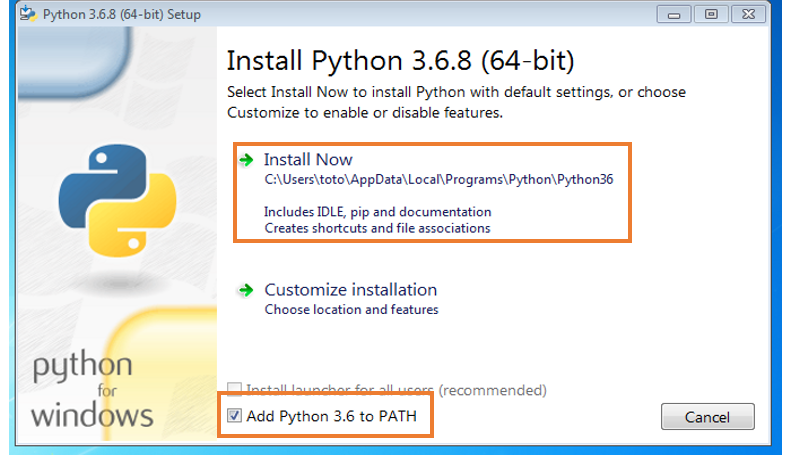

- #PYTHON 3.6 INSTALL FOR WINDOWS HOW TO#
- #PYTHON 3.6 INSTALL FOR WINDOWS UPDATE#
- #PYTHON 3.6 INSTALL FOR WINDOWS ARCHIVE#
- #PYTHON 3.6 INSTALL FOR WINDOWS CODE#
#PYTHON 3.6 INSTALL FOR WINDOWS ARCHIVE#
Now remove downloaded source archive file from your system rm /usr/src/Python-3.6.10.tgzĬheck the latest version installed of python using below command. Make altinstall is used to prevent replacing the default python binary file /usr/bin/python.
#PYTHON 3.6 INSTALL FOR WINDOWS CODE#
Use below set of commands to compile Python source code on your system using altinstall. You can also download the latest version in place of specified below.
#PYTHON 3.6 INSTALL FOR WINDOWS HOW TO#
Read: How to Use SSH to Connect Remote Linux Serverĭownload Python using the following command from the Python official site. yum install gcc openssl-devel bzip2-devel sqlite-devel Now, use the following command to install prerequisites for Python before installing it. Login to your server using ssh or shell access. This Python installation required GCC compiler on your system. This tutorial will help you to install Python 3.6.10 on your CentOS, Red Hat & Fedora operating systems. At writing time of this article Python 3.6.10 latest stable version is available to download and install. Even with gedit you can write your codes without problems.Python is a powerful programming language. So you can always use Sublime Text 3 to develop your codes in this language or any other editor. Just say that if the shell that provides us with these facilities is a bit "austere", for many it is a bit short and uncomfortable. Hope this tutorial helps you install Python on Ubuntu 16.10 and Ubuntu 17.04. To exit the shell you just have to type: quit() Once this is done, you can use the shell provided by the installation to write your codes by typing the following command in terminal: python3.6 This order may take a while, so be patient. configure –enable-optimizations sudo make altinstallīy using the altinstall command we will skip the creation of the symbolic link. If you get an error when executing the previous command, you can try the following. Then we are going to configure the compilation environment and install. Once the extraction is finished, we are going to move to the directory where it was extracted using the cd command. Once the download is finished, it is time to extract the contents of the package. Once the installation is finished, we will download the source code from the official page using wget. sudo apt install build-essential checkinstall sudo apt install libreadline-gplv2-dev libncursesw5-dev libsqlite3-dev tk-dev libgdbm-dev libc6-dev libbz2-dev First, some build dependencies will have to be installed using the following commands. Now we are going to see how to install Python from scratch by downloading and complicating the package that we are going to download. Python 3.6.0 Download, compile and install Python 3.6 on Ubuntu 

The previous command will show us a message like this on the screen: Once the installation is finished, we are going to check the version that we have just installed by typing the following in the terminal: python3.6 -V
#PYTHON 3.6 INSTALL FOR WINDOWS UPDATE#
Python 3.6 is included in the university repository for Ubuntu 16.10 and Ubuntu 17.04, so it can be easily installed with the following commands: sudo apt update sudo apt install python3.6

Installing Python 3.6 on Ubuntu 16.10, Ubuntu 17.04 from the universal repository 2 Download, compile and install Python 3.6 on Ubuntu.1 Installing Python 3.6 on Ubuntu 16.10, Ubuntu 17.04 from the universal repository.








 0 kommentar(er)
0 kommentar(er)
